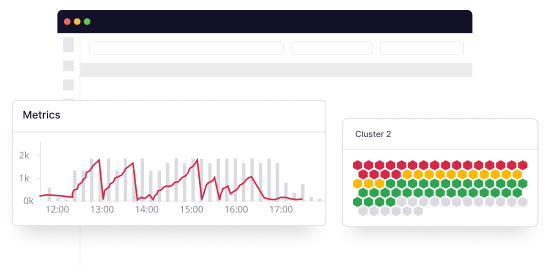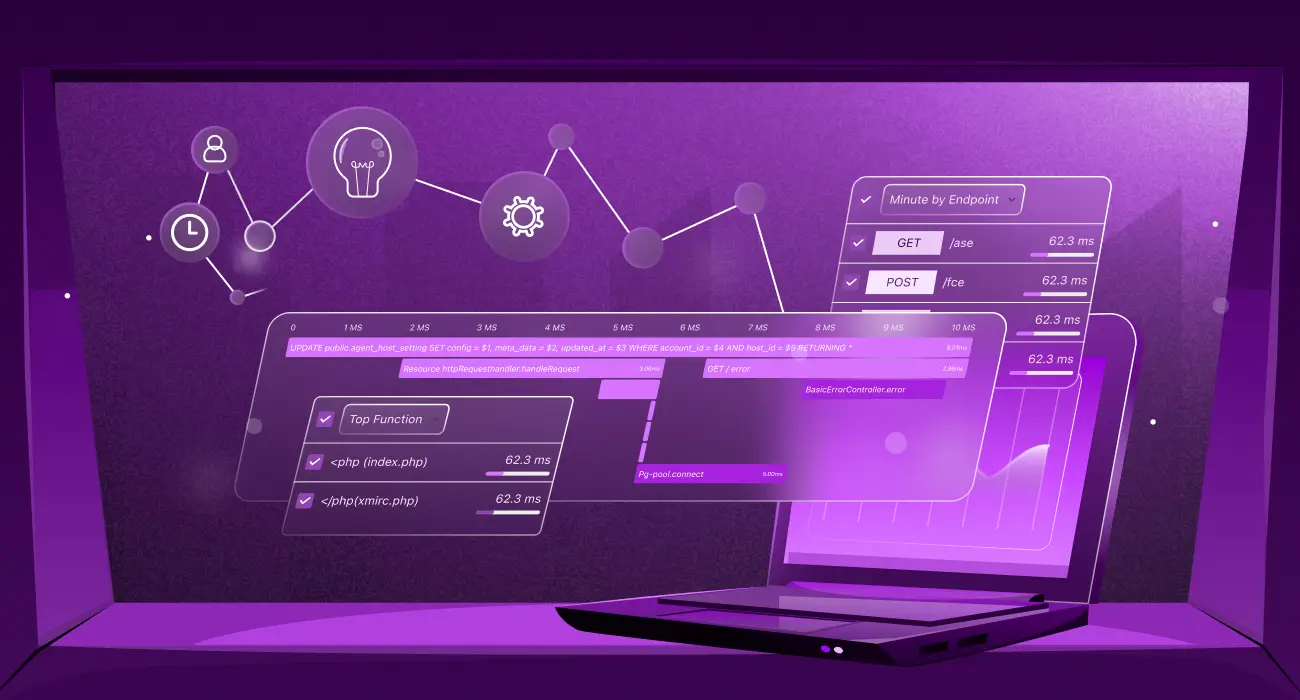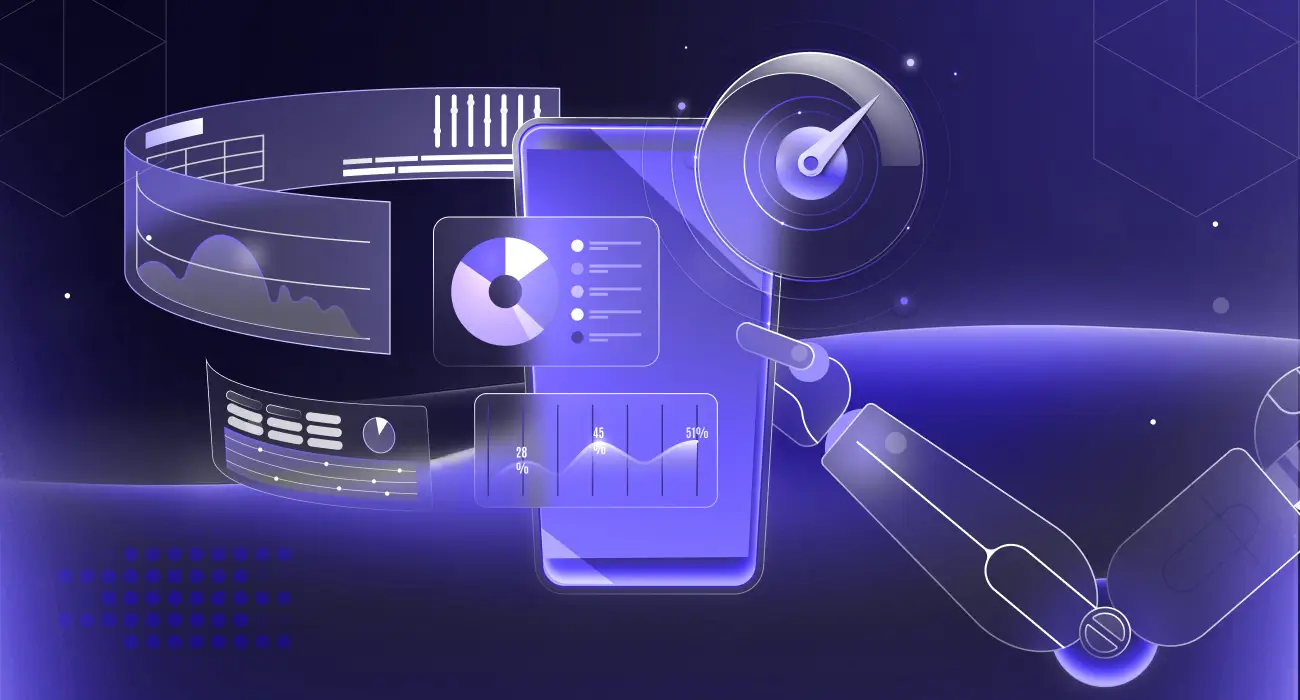In recent years, the ubiquity of mobile computing has required application developers to deploy actions quickly and make changes to applications without complete redeployment. This has led to a new development paradigm called “microservices.”
Microservices are lightweight, self-contained components that perform respective functions within an application, communicating with each other via APIs.
This new approach seems quite popular, as 85% of companies are using microservices as part of their architecture.
Although independent of each other, these microservices work together to achieve the desired results.
Since microservices have become a critical component of modern application architecture, let’s take a look at what they are, how they work, and the value they can provide.
What are Microservices?
Microservices, often referred to as Microservices architecture, is an architectural approach that involves dividing large applications into smaller, functional units capable of functioning and communicating independently.
This approach arose in response to the limitations of monolithic architecture. Because monoliths are large containers holding all software components of an application, they are severely limited: inflexible, unreliable, and often develop slowly.
With microservices, however, each unit is independently deployable but can communicate with each other when necessary. Developers can now achieve the scalability, simplicity, and flexibility needed to create highly sophisticated software applications.
How Does Microservices Architecture Work?
Microservices architecture focuses on classifying otherwise large, bulky applications. Each microservice addresses an application’s particular aspect and function, such as logging, data search, and more. Together, these microservices form a single application.
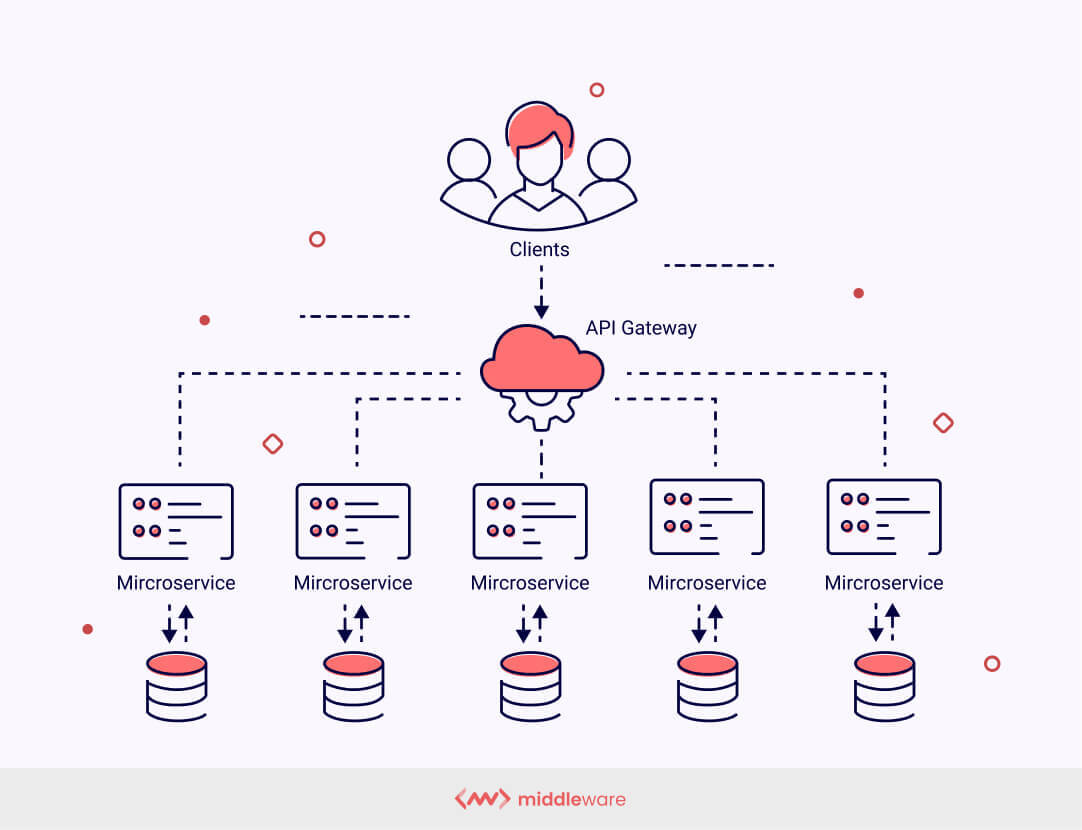
The client can use the user interface to generate requests. At the same time, one or more microservices are commissioned through the API gateway to perform the requested task. As a result, even larger complex problems that require a combination of microservices can be solved relatively easily.
Microservices systems facilitate each component service’s independent building, operation, scaling, and deployment. There is no sharing of the codes or functionality with other services. The use of well-defined APIs propagates communication between the program’s various components.
Depending on a specific issue, every service in the system is tailored to a unique set of skills. The services may further break down into more minor services if the developers provide additional code. This gives developers many options for solving potential problems—even ones they may not realize they have yet.
Microservices vs. Monolithic Architecture
To better understand microservices architecture, let’s compare it to the legacy approach: monolithic architecture. In short, microservices are collections of smaller, independently deployable services, while monoliths are built as single unified systems.
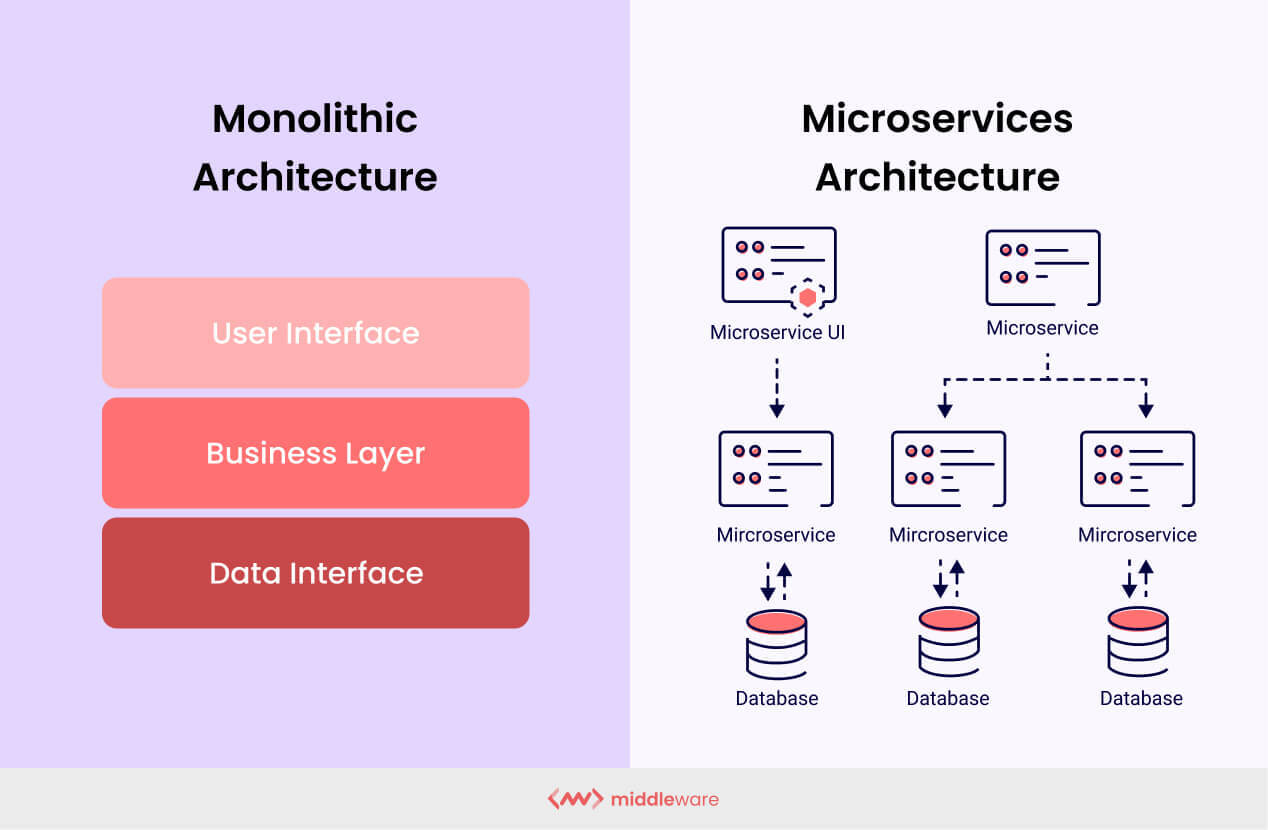
One of the key advantages of monolithic architecture is that it’s self-contained and independent from other applications. This allows for easy deployment & development, simplified testing, easy debugging, and streamlined performance.
However, monolithic architecture has its drawbacks, including slower development speed, challenges in scalability, and the fact that individual errors can affect the entire application’s availability.
On the other hand, Microservices architecture is a more agile, flexible, and scalable solution. A major advantage of microservices is that it enables continuous deployment and faster release cycles. It’s also highly maintainable and testable and allows more flexibility in technology options.
However, microservices architecture can also lead to development sprawl, ballooning costs and overhead, and debugging challenges due to high volumes of log data.
Key Benefits of Microservices Architecture
Microservices architecture presents developers and engineers with a number of benefits that monoliths cannot provide. Here are a few of the most notable.
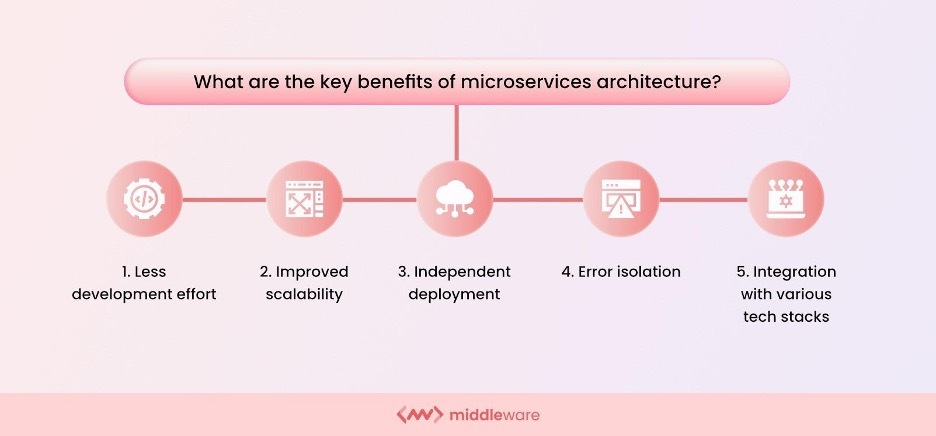
1. Less Development Effort
Smaller development teams can work in parallel on different components to update existing functionalities. This makes it significantly easier to identify hot services, scale independently from the rest of the application, and improve the application.
2. Improved Scalability
Microservices launch individual services independently, developed in different languages or technologies; all tech stacks are compatible, allowing DevOps to choose any of the most efficient tech stacks without fearing if they will work well together.
These small services work on relatively less infrastructure than monolithic applications by choosing the precise scalability of selected components per their requirements.
3. Independent Deployment
Each microservice constituting an application needs to be a full stack. This enables microservices to be deployed independently at any point. Since microservices are granular in nature, development teams can work on one microservice, fix errors, and then redeploy it without redeploying the entire application.
Microservice architecture is agile, and thus, modifying the program by adding or changing a line of code or adding or eliminating features does not require a congressional act. The software streamlines business structures through resilience improvisation and fault separation.
4. Error Isolation
In monolithic applications, the failure of even a small component can make the overall application inaccessible. Determining the error can also be tedious in some cases.
With microservices, isolating the problem-causing component is easy since the entire application is divided into standalone, fully functional software units. If errors occur, other non-related units will still continue to function.
5. Integration with Various Tech Stacks
With microservices, developers have the freedom to pick the tech stack best suited for one particular microservice and its functions. Instead of opting for one standardized tech stack encompassing all of an application’s functions, they have complete control over their options.
Honorary Mentions
1. Programming Language Agnostic
Developers have the power to choose the programming language for building their microservice application, as it can be programmed in any language. As microservice architectures are language agnostic, developers can make the most of their exciting skills without any pressure to learn a new language.
2. High Reusability
Most microservice applications are inherently diverse, making them a shareable resource across business units. As long as the application’s purpose/intent remains the same, its performance doesn’t change.
For instance, if multiple business units require a platform to log in, the same application can be used across the board. This saves developers and the entire business considerable time and resources, as they don’t have to recreate apps for a single use case.
3. Disruption-Free Deployment
Developers can develop and deploy new microservices applications or features within existing applications without creating service outages or conflicts with other codes. Even if they have multiple microservices in the pipeline, each one of them can be deployed independently and simultaneously.
What Is the Microservices Architecture Used For?
Put simply: microservices architecture makes app development quicker and more efficient. Agile deployment capabilities combined with the flexible application of different technologies drastically reduce the duration of the development cycle. The following are some of the most vital applications of microservices architecture.
Data Processing
Since applications running on microservice architecture can handle more simultaneous requests, microservices can process large amounts of information in less time. This allows for faster and more efficient application performance.
Media Content
Companies like Netflix and Amazon Prime Video handle billions of API requests daily. Services such as OTT platforms offering users massive media content will benefit from deploying a microservices architecture. Microservices will ensure that the plethora of requests for different subdomains worldwide is processed without delays or errors.
Website Migration
Website migration involves a substantial change and redevelopment of a website’s major areas, such as its domain, structure, user interface, etc. Using microservices will help you avoid business-damaging downtime and ensure your migration plans execute smoothly without any hassles.
Transactions and Invoices
Microservices are perfect for applications handling high payments and transaction volumes and generating invoices for the same. The failure of an application to process payments can cause huge losses for companies. With the help of microservices, the transaction functionality can be made more robust without changing the rest of the application.
Microservices Tools
Building a microservices architecture requires a mix of tools and processes to perform the core building tasks and support the overall framework. Some of these tools are listed below.
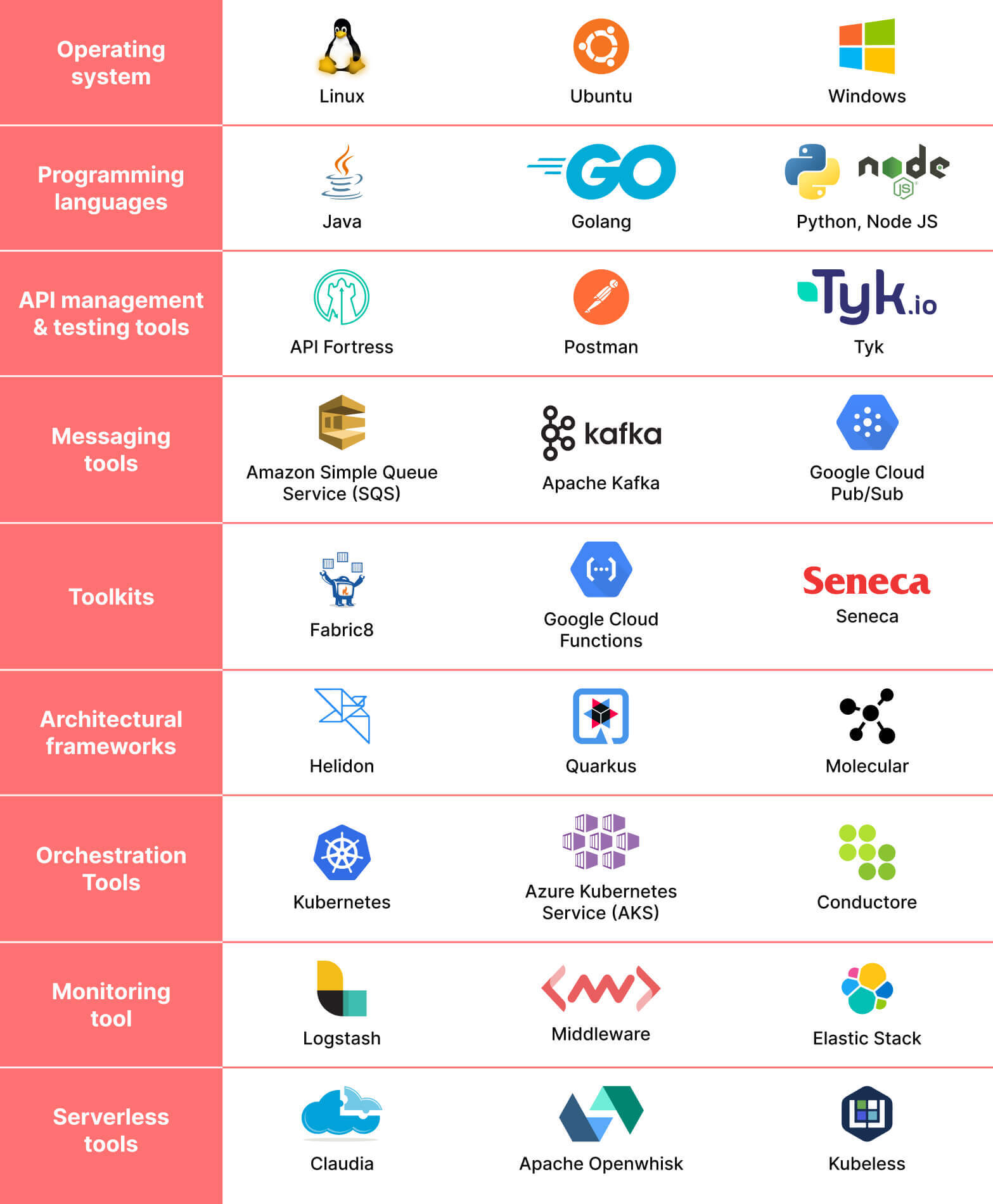
1. Operating System
The most basic tool required to build an application is an operating system (OS). One such operating system allows great flexibility in development and uses in Linux. It offers a largely self-contained environment for executing program codes and a series of options for large and small applications in terms of security, storage, and networking, making it highly favorable for firms that build applications.
2. Programming Languages
One of the benefits of using a microservices architecture is that you can use a variety of programming languages across applications for different services. Different programming languages have different utilities deployed based on the nature of the microservice.
3. API Management and Testing Tools
The various services need to communicate when building an application using a microservices architecture. This is accomplished using application programming interfaces (APIs). For APIs to work optimally and desirably, they need to be constantly monitored, managed and tested, and API management and testing tools are essential for this.
4. Messaging Tools
Messaging tools enable microservices to communicate both internally and externally. RabbitMQ and Apache Kafka are examples of messaging tools deployed as part of a microservice system.
5. Toolkits
Toolkits in a microservices architecture are tools used to build and develop applications. Different toolkits are available to developers, and these kits fulfill different purposes. Fabric8 and Seneca are some examples of microservices toolkits.
6. Architectural Frameworks
Microservices architectural frameworks offer convenient solutions for application development and usually contain a library of code and tools to help configure and deploy an application.
7. Orchestration Tools
A container is a set of executables, codes, libraries, and files necessary to run a microservice. Container orchestration tools provide a framework to manage and optimize containers within microservices architecture systems.
8. Monitoring Tools
Once a microservices application is up and running, you must constantly monitor it to ensure everything is working smoothly and as intended. Monitoring tools help developers stay on top of the application’s work and avoid potential bugs or glitches.
9. Serverless Tools
Serverless tools further add flexibility and mobility to the various microservices within an application by eliminating server dependency. This helps in the easier rationalization and division of application tasks.
5 Challenges of Microservices Architecture
The microservices architecture comes with its fair share of challenges, from deployment to operation and maintenance. Some of these challenges are discussed below.
1. Inter-service Communication
Although microservices can exist and function independently, they often need to interact and communicate with other microservices to fulfill certain demands or tasks. This necessitates maintaining a fully functional API as a communication channel between various services.
2. Distributed Logging
When different and independently operating microservices are deployed as part of an application, each of these services has a distinct logging mechanism. This results in large volumes of distributed log data that are unstructured and difficult to organize and maintain.
3. Transaction Spanning
Distributed transactions refer to transactions requiring the deployment and proper functioning of a series of microservices. This means that a transaction spans multiple microservices and databases, making a small failure in one element cause failure across the entire transaction.
4. Cyclic Dependencies Between Services
A cyclic dependency in a microservices architecture refers to the codependency of two or more application services or modules. Cyclic dependencies can make it difficult to scale the application or independently deploy and manage microservices. They’re also infamous for making code more complex to maintain. If they persist for long, decoupling becomes close to impossible.
5. Threat to Data Integrity
Data is typically disturbed In a micro servers-based framework. Meaning, it’s extremely difficult to maintain confidentiality and integrity of user data. Apart from that, it’s challenging to set up access control, administer secured authentication to individual users or services, and address the vulnerabilities driven by the increased attack surface.
Microservices Architecture Examples
With recent advances in cloud technology, many big brands have now advocated moving from a monolithic to a microservices architecture for better functionality. Let’s look at two such companies that have vastly improved their business by leveraging microservices.
Amazon
If you look at Amazon’s retail website in 2001, it essentially worked as a single, monolithic application. The lack of application flexibility made developers struggle while untangling dependencies when upgrading or scaling the services. As a result, Amazon struggled to meet the needs of its rapidly growing customer base.
To solve this issue, the Amazon development team split the large, monolithic application into smaller, independent services managed and handled by separate developer teams. Amazon’s efforts eventually led to the creation of a highly decoupled, service-oriented architecture that we now refer to as microservices architecture.
Netflix
Netflix started its movie streaming business in 2007. It started facing severe scalability issues and service outages within just a year. In 2008, Netflix failed to ship DVDs to customers for three consecutive days. This was when they decided to switch to a distributed cloud system with Amazon Web Services (AWS) as the cloud provider.
Later in 2009, Netflix began moving its application architecture from monolithic to microservices, and this process was finally completed in 2012.
This move to a microservices architecture enabled Netflix to overcome its scalability challenges and offer its services to millions around the world. In 2015, Netflix’s API gateway successfully processed 2 billion API requests daily – thanks to a group of over 500 cloud-hosted microservices. The cost of streaming was also reduced, which allowed Netflix to make significant financial gains.
Top 10 Microservices Best Practices for 2025
One of the features of microservices is that they are constantly evolving. As such, engineers need to always be aware of upcoming changes and continually refresh their best practices. Here are some best practices that will be important in 2025.
1. Clearly Define Your Microservices
IT organizations ranging from startups to Fortune 50 companies all use microservices architecture. But just because it’s worked for someone else doesn’t mean it’ll work for you. Make sure you understand the value a microservices architecture can add to your technology, and invest in the tools that make the most sense.
There must be a clear differentiation between business functions, services, and microservices. Without these boundaries, your microservices may become too large—which means no one will realize the benefits from a microservices approach.
At the other end of the spectrum, there’s the possibility of over-fragmentation, which means having too many microservices. This will cause your operational management costs to skyrocket, and this will likely overshadow whatever benefits you receive.
The key here is to strike a balance by designing specialized services according to in-application functions. Some business functions would probably have more in-application tasks than others.
2. Deploy and Host Microservices Separately
If you want to minimize each service’s resources, it’s important to deploy microservices separately. By using dedicated infrastructure to host microservices, you can isolate them from errors in other services, minimizing the likelihood of a complete outage.
Additionally, containerizing microservices enables platform interoperability without compromising microservice independence.
3. Build Microservices with Domain-Driven Design (DDD)
Domain-driven design (DDD) is a design principle that expresses an object-oriented model using practical rules and ideas. Specifically, it involves designing microservices around business domains. Helping software architectures understand different business domains enables them to focus on building microservices architecture in a way they can understand well.
4. Get Early Buy-In from Key Stakeholders
Implementing your microservice architecture requires more buy-in than your engineering team. The costs of transformation, business impact, and organizational restructuring necessitate gathering buy-in from all stakeholders involved.
These stakeholders include your executive team but go all the way down the organization. Microservices architecture requires a cultural transformation and a change in the very way your business operates. This requires buy-in from the bottom up, not just the top down.
5. Use RESTful APIs
RESTful APIs are highly advantageous for microservices architecture simply because they require no installation on the client side. Without the need for clunky SDKs or frameworks, you can streamline your architecture and provide more value to stakeholders and end users.
6. Create Unique Provisions for Each Microservice’s Data Storage
While data can and should be shared via APIs across all your microservices, each one should have provisions to fully own its data. If multiple microservices share the same data storage, this will lead to coupling between services—defeating the purpose of microservices altogether.
7. Backward Compatibility Is a Must
Backward compatibility plays a crucial role in microservices versioning. It ensures that systems do not break or fail if and when changes are made. The best way to ensure backward compatibility is by agreeing to contract services.
However, in the event a single service breaks the contract, the entire system is at the risk of falling apart. So you need to up the ante by first using Postel’s Law to ensure backward compatibility for service endpoints.
It’s a simple approach that recommends being conservative about what you send and liberal about what’s revealed.
8. Refrain from Hardcoding Values
Hardcoding values might lead to system-wide issues driven by network-based changes. It’s best not to do it at all. Rather, you can leverage network discovery mechanisms that use a service register or proxy. This way, connecting and executing functions becomes easy once you integrate network discovery tools.
9. Understand Parallelism and Immutability
These two concepts are very interrelated in the world of microservices. While parallelism helps you do more in less time, Immutability is the concept of creating data or objects once and never modifying them.
To put things into perspective, microservices architectures can be greatly simplified with parallel programming, and immutable containers can improve latency, security, and more.
Also, even if changes are made across the system via parallel programming, immutable APIs will restrict the side effects of that change on others.
10. Invest in Observability
Microservice architecture is exponentially more complex than monoliths. As such, traditional monitoring methods don’t work like they have in the past. This is why as part of your microservices transformation, you should invest in an observability platform.
By collecting metrics, logs, and traces, observability platforms gather all your data into one location, surfacing the most important insights. You can trace issues back to their root cause, no matter which microservice the error impacted.
That way, your development team can spend less time diagnosing an issue and more time actually fixing it.
Final thoughts on microservices
Microservices architecture solves a number of major challenges that developers have faced with their traditional monolithic solutions. However, development sprawl and alert fatigue can create their own challenges.
As such, it’s important to have an observability platform built specifically for microservices architecture. By managing the influx of logs and surfacing the most important insights, observability can help developers and engineers get the best of both worlds—the flexibility and scalability of microservices with the structure and visibility of a monolith.


